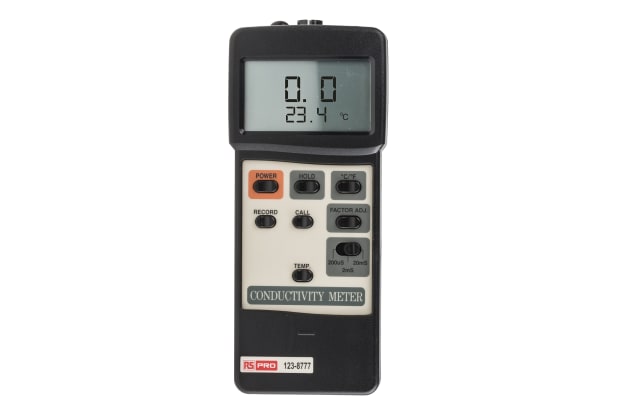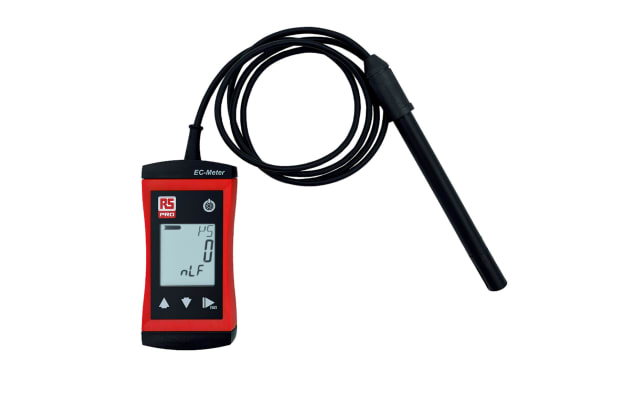- Published 15 Mar 2023
- Last Modified 27 Nov 2023
- 6 min
Guide to Units of Conductivity
Find out all about what conductivity is and how to measure it effectively.

Reviewed by Mithun Subbaroybhat, Technical Support Engineer (October 2022)
Conductivity is a measurement that shows how well an element passes through a material. Electricity and heat are the main elements that are conducted through other materials. Hence the main units for conductivity are thermal and electrical.
From evaluating the quality of substances to finding the source of leaks or checking the function of circuit boards, these measurements are helpful in a range of manufacturing and engineering processes.
This guide on units of conductivity will give you all the information you need about conductivity, its units, and how to measure it accurately.
What is a Conductivity Meter Used for?
Conductivity meters are used to measure how well heat or electricity passes through a particular material or substance. Electrical and thermal conductivity meters look similar, but they have different applications. Both types of instruments use a system of probes linked to a main reader - however, depending on the substance being assessed and the specific measurements needed, there are two variations of each meter type.
The two variations of electrical conductivity meters are:
- Inductive: these measure conductivity by passing an alternating voltage between two coils (called driving and receiving coils) to measure the induced current and how it’s resisted by the solution being tested
- Contacting: by putting two insulated electrodes in contact with a material, these meters pass an alternating voltage between them to measure the current and level of resistance from the material
The two variations of thermal conductivity meters are:
- Steady-state: these take conductivity measurements while the heat of a material or solution stays constant
- Transient: these take regular measurements as the material or solution is heated up to a set temperature
What Does a Conductivity Meter Measure?

Conductivity meters are used to measure the ability of a material or solution to transfer heat energy or electricity. Depending on the specific item being analysed or the measurement needed, different meters and methods can be used by those performing the tests.
Understanding the electrical conductivity of a material can help in a variety of manufacturing processes and quality checks. The quality of metal, the stress resistance of a material and the purity of a liquid solution can all be decided by measuring a material’s electrical conductivity.
Similarly, thermal conductivity can help manufacturers in a range of sectors. In construction, it can help to select the right materials to make a building energy efficient. In electronics, thermal conductivity measurements help to design circuits with effective thermal management. For food and beverage manufacturers, the quality and safety of many products depend on understanding their thermal conductivity.
What are the Units of Thermal Conductivity?
Historically, different systems of measurement have led to a range of thermal conductivity units of measurement. However, the international standard (SI) unit that’s widely accepted for thermal conductivity is Watts per metre-Kelvin or W/mK.
This measurement is calculated using this process:
- Multiplying the amount of heat transferred through the material in Joules per second or Watts (Q) by the distance between the two points of measurement (L)
- Multiplying the area of the surface being measured in square metres (A) by the difference in temperature in Kelvin between the two points of measurement (𝛥T)
- Dividing the first value by the second value to reach the measurement of thermal conductivity (K)
- The formula for calculating thermal conductivity is K = (QL)/(AΔT)
What are the Units of Electrical Conductivity?
Though you may come across several electrical conductivity units of measure, the SI unit that’s internationally recognised is Siemens per metre or S/m. This is calculated using Ohm’s Law. Ohm's Law states that the current through a conductor between two points is directly proportional to the voltage across the two points.
- Multiplying the current produced (I) by the voltage supplied to the substance (V) to get the value of resistance (R)
- Getting the reciprocal of R by dividing it from 1. This will give the value of conductance (G)
- Dividing this value (G) by the length of the material being measured (x) to get the final value (S/m)
How Does a Conductivity Meter Work?
Each type of conductivity meter works slightly differently to measure the transfer of heat or electricity.
- Inductive electrical conductivity meters are only used to measure the conductivity of solutions. When immersed, the drive coil sends out an alternating voltage which induces a voltage in the receiving coil. This causes a current to be generated in the solution which can then be measured to calculate the conductivity
- Contacting electrical conductivity meters have two probes, a cathode and an anode, which are put in contact with either side of the material being tested. An alternating voltage is passed between these two probes to generate a current which can be used to calculate the conductivity of the material
- Thermal conductivity meters will pass heat through a sample using probes, planes or other heating elements and measure the resulting temperature change in the sample. Some sensors will use measurements of voltage and calibrate them to temperature values to calculate the thermal conductivity of a material or solution. Meters may take several readings with increasing temperatures (transient) or similar temperatures (steady state) to get a more accurate result
How to Read a Conductivity Meter

Each conductivity meter display will look slightly different. However, once you place the probes, planes or other elements on the sample and press a start button, a measurement should be taken by the meter. This will usually then be displayed in the relevant SI unit unless the settings on the meter are changed. Several measurements may need to be taken as part of your tests. These are usually stored on the meter itself or can be recorded manually after each reading.
How to Calibrate a Conductivity Meter
Every conductivity meter will come with calibration instructions. This usually involves using a calibration sample with a known electrical or thermal conductivity value, running multiple readings on it and adjusting the meter until it matches the known value. An alternative way to calibrate a conductivity meter is to run several readings of the same solution or material in conjunction with a referee (already calibrated) meter. However, to make sure your calibration is accurate, it’s important to follow the procedure set out in your model’s manual. Alternatively, take a look at our calibration service.


